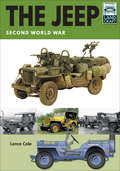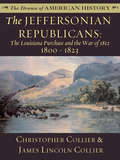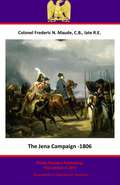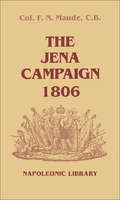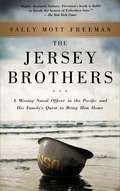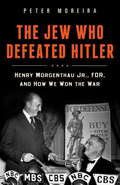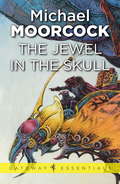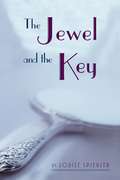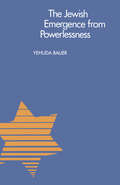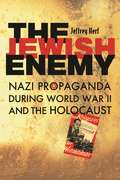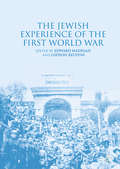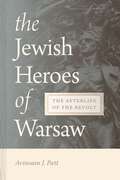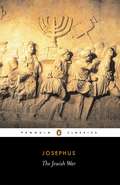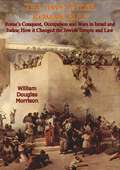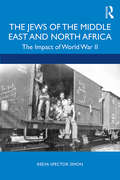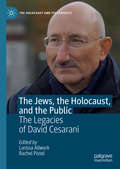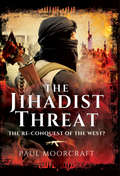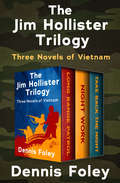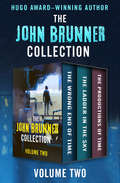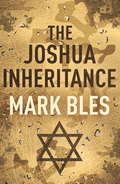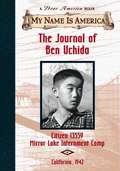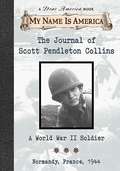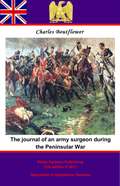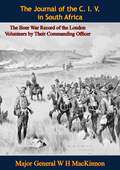- Table View
- List View
The Jeep: Second World War (LandCraft)
by Lance Cole&“The Jeep is as iconic a military vehicle as the Chieftain tank, and this terrific book celebrates it in brilliant style . . . inspiring.&” —Books Monthly The Second World War Jeep was one of the most famous and influential military vehicles of all time, and over 600,000 were produced. It served with all the Allied forces during the war on every front and it has been the inspiration behind the design of light, versatile, rugged military and civilian vehicles ever since. In this, the first volume in Pen & Sword&’s LandCraft series, Lance Cole traces the design, development and manufacturing history of the Jeep and describes its operational role within the Allied armies. A selection of archive photographs showing the Jeep in service in European and Pacific campaigns gives a graphic impression of how adaptable the Jeep was and records the variety of equipment it could carry. The book is an excellent source for the modeler, providing details of available kits, together with specially commissioned color profiles recording how the Jeeps used by different units and armies appeared. Lance Cole&’s introduction to the Jeep is necessary reading and reference for enthusiasts and modelers. &“If you are a modeler looking for guidance and inspiration then this book is a must have. Its pages are packed full of jeep goodness, giving tips and ideas for your build. It is also a great read, or coffee-time browser, if you are a vehicle enthusiast or simply love Willys/Ford jeeps and merely want to stimulate your brain and satisfy your eyes.&” —The OCAD Collection
The Jeffersonian Republicans: 1800 - 1823
by James Lincoln Collier Christopher CollierHistory is dramatic -- and the renowned, award-winning authors Christopher Collier and James Lincoln Collier demonstrate this in a compelling series aimed at young readers. Covering American history from the founding of Jamestown through present day, these volumes explore far beyond the dates and events of a historical chronicle to present a moving illumination of the ideas, opinions, attitudes and tribulations that led to the birth of this great nation. The Jeffersonian Republicans examines various events between 1800 and 1823 that helped to shape the United States. The Louisiana Purchase, the War of 1812, and important Supreme Court decisions are among the discussed events. The text is enhanced with images of art & artifacts, maps, and photographs of historic significance.
The Jena Campaign - 1806 (The Special Campaigns Series #9)
by Colonel Frederic Natusch Maude, C.B., late R.E.This ebook is purpose built and is proof-read and re-type set from the original to provide an outstanding experience of reflowing text for an ebook reader. Prussia had sat on the sidelines in 1805 whilst Napoleon hammered the Austrian and Russian armies in a dazzling series of victories culminating at the battle of Austerlitz. As the court of Frederick William III awaited a favourable moment to intervene, they looked on their army with a misplaced confidence based on the deeds of Frederick the Great, his well-drilled infantry and daring cavalry. However, the army had not kept up with the development of the French: their training suffered the constraints of financial cut-backs, their leaders were divided, vain, egocentric, incompetent or just too plain old. Frederick William was determined to cross swords with Napoleon, using a violation of territory by the French the year before as a pretext he started to mobilise his troops. His opponent was at the height of his military power. Although he did not really want to have another war so soon after crushing Austria, Napoleon was not the sort of man to back down from a challenge from the Prussians. As the troops readied themselves for the upcoming war, the Prussian generals vacilitated, abrogated responsibility, argued and split their forces. Napoleon organised his men into three mutually supporting columns as he invaded Prussian territory, unable to divine the intentions of his opponents. He was ready for all situations. Napoleon with his main army faced a sizeable portion of the Prussian forces at Jena, whilst Davout, perhaps his best subordinate, stood outnumbered but unshaken at Auerstädt. The fighting was brutal, short and bloody and would lead to Prussia being humbled for years to come, seething for revenge. This book formed part of the Special Campaigns series, which was written in the early years at the turn of the twentieth century to provide detailed assessments of the historic campaigns of the past for the benefit of the officers of the British Army. They were all written by current or recently retired officers of the Army who shared their wealth of experience and insight to a new generation, each officer having had a specialist area of expertise. Colonel Maude was an authority on the campaigns of Napoleon, and wrote three volumes for the series, the others focussing on the 1805 and 1813 campaigns. He describes the campaign in brilliant vivid detail, using material from the official archives of both France and Prussia as well as numerous eye-witness details. A fascinating book in an excellent series. Author - Colonel Frederic Natusch Maude, C.B., late R.E. (1854-1933) Text taken, whole and complete, from the edition published in 1909, London, by Swan Sonnenschein Original - 202 pages. Illustrations - 5 Maps and Diagrams, 4 A3 maps have been omitted due to their size. Linked TOC
The Jena Campaign, 1806: 1806-the Twin Battles Of Jena And Auerstadt Between Napoleon's French And The Prussian Army (The Napoleonic Library #Vol. 33)
by F. N. MaudeIn this balanced and gripping narrative of t he Jena Campaign, Maude gives the reader an insight into the strengths and weaknesses of the 2 opposing armies. With the diagrams that show the 2 sides'' positions, the battle can b e followed with ease.
The Jersey Brothers: A Missing Naval Officer in the Pacific and His Family's Quest to Bring Him Home
by Sally Mott FreemanThe extraordinary, real-life adventure of three brothers at the center of the most dramatic turning points of World War II and their mad race to change history—and save one of their own.They are three brothers, all Navy men, who end up coincidentally and extraordinarily at the epicenter of three of the war’s most crucial moments. Bill is picked by Roosevelt to run his first Map Room in Washington. Benny is the gunnery and anti-aircraft officer on the USS Enterprise, one of the only carriers to escape Pearl Harbor and by the end of 1942 the last one left in the Pacific to defend against the Japanese. Barton, the youngest and least distinguished of the three, is shuffled off to the Navy Supply Corps because his mother wants him out of harm’s way. But this protection plan backfires when Barton is sent to the Philippines and listed as missing-in-action after a Japanese attack. Now it is up to Bill and Benny to find and rescue him. Based on ten years of research drawn from archives around the world, interviews with fellow shipmates and POWs, and primary sources including diaries, unpublished memoirs, and letters half-forgotten in basements, The Jersey Brothers is a remarkable story of agony and triumph—from the home front to Roosevelt’s White House, and Pearl Harbor to Midway and Bataan. It is the story, written with intimate, novelistic detail, of an ordinary young man who shows extraordinary courage as the Japanese do everything short of killing him. And it is, above all, a story of brotherly love: of three men finding their loyalty to each other tested under the tortures of war—and knowing that their success or failure to save their youngest brother will shape their family forever.
The Jew Who Defeated Hitler
by Peter MoreiraPresident Franklin D. Roosevelt coined the slogan "The Arsenal of Democracy" to describe American might during the grim years of World War II. The man who financed that arsenal was his Secretary of the Treasury, Henry Morgenthau Jr. This is the first book to focus on the wartime achievements of this unlikely hero--a dyslexic college dropout who turned himself into a forceful and efficient administrator and then exceeded even Roosevelt in his determination to defeat the Nazis. Based on extensive research at the FDR Library in Hyde Park, NY, author Peter Moreira describes Morgenthau's truly breathtaking accomplishments: He led the greatest financial program the world has ever seen, raising $310 billion (over $4.8 trillion in today's dollars) to finance the war effort. This was largely done without the help of Wall Street by appealing to the patriotism of the average citizen through the sale of war bonds. In addition, he championed aid to Britain before America entered the war; initiated and oversaw the War Refugee Board, spearheading the rescue of 200,000 Jews from the Nazis; and became the architect of the 1944 Bretton Woods Conference, which produced the modern economic paradigm. The book also chronicles Morgenthau's many challenges, ranging from anti-Semitism to the postwar "Morgenthau Plan" that was his undoing. This is a captivating story about an understated and often overlooked member of the Roosevelt cabinet who played a pivotal role in the American war effort to defeat the Nazis.
The Jewel In The Skull (Gateway Essentials #446)
by Michael MoorcockDorian Hawkmoon, the last Duke of Koln, swore to destroy the Dark Empire of Granbretan. But after his defeat and capture at the hands of the vast forces of the Empire, Hawkmoon becomes a puppet, co-opted by his arch nemesis, the ruthless Baron Meliadus, to infiltrate the last stronghold of rebellion against Granbretan: the small but powerful city of the Kamarg. He has been implanted with a black jewel, through which the Dark Empire can control his every decision. But in the stronghold of the Kamarg, Hawkmoon discovers the power inside him to overcome any control, and his vengeance against the Dark Empire is filled with an unrelenting fury.
The Jewel and the Key
by Louise SpieglerAn earthquake and the discovery of a mysterious antique mirror unleash forces that jolt sixteen-year-old Addie McNeal back to 1917 Seattle, just as the United States is entering World War I. Addie finds herself shuttling back and forth between past and present, drawn in both times to the grand Jewel Theater. In both decades the existence of the Jewel is threatened and war is looming . . . and someone she cares about is determined to fight. Eventually, Addie realizes that only she has the key to saving the Jewel--and the lives of her friends. But will she figure out how to manipulate the intricately woven threads of time and truly set things right?
The Jewish Emergence from Powerlessness
by Yehuda BauerThe theme of this book is the gradual emergence of the Jewish people from total political powerlessness - a development stretching over nearly 100 years and culminating in the consolidation in the State of Israel. Ironically, Professor Bauer demonstrates, events during this period stemmed in part from a belief in the power of the international Jewish community that never existed - but that motivated both the Germans and, after the war, the British.This is a brief but absorbing study by one of the world's great experts on the Holocaust, who has drawn on a huge body of material to depict one of the unforgettable events in recent history from an arresting and unfamiliar point of view.
The Jewish Enemy: Nazi Propaganda during World War II and the Holocaust
by Jeffrey Herf<p>The sheer magnitude of the Holocaust has commanded our attention for the past sixty years. The extent of atrocities, however, has overshadowed the calculus Nazis used to justify their deeds. <p>According to German wartime media, it was German citizens who were targeted for extinction by a vast international conspiracy. Leading the assault was an insidious, belligerent Jewish clique, so crafty and powerful that it managed to manipulate the actions of Roosevelt, Churchill, and Stalin. Hitler portrayed the Holocaust as a defensive act, a necessary move to destroy the Jews before they destroyed Germany. <p>Joseph Goebbels, Minister of Propaganda, and Otto Dietrich’s Press Office translated this fanatical vision into a coherent cautionary narrative, which the Nazi propaganda machine disseminated into the recesses of everyday life. Calling on impressive archival research, Jeffrey Herf recreates the wall posters that Germans saw while waiting for the streetcar, the radio speeches they heard at home or on the street, the headlines that blared from newsstands. The Jewish Enemy is the first extensive study of how anti-Semitism pervaded and shaped Nazi propaganda during World War II and the Holocaust, and how it pulled together the diverse elements of a delusionary Nazi worldview. Here we find an original and haunting exposition of the ways in which Hitler legitimized war and genocide to his own people, as necessary to destroy an allegedly omnipotent Jewish foe. In an era when both anti-Semitism and conspiracy theories continue to influence world politics, Herf offers a timely reminder of their dangers along with a fresh interpretation of the paranoia underlying the ideology of the Third Reich.</p>
The Jewish Experience of the First World War
by Edward Madigan Gideon ReuveniThis book explores the variety of social and political phenomena that combined to the make the First World War a key turning point in the Jewish experience of the twentieth century. Just decades after the experience of intense persecution and struggle for recognition that marked the end of the nineteenth century, Jewish men and women across the globe found themselves drawn into a conflict of unprecedented violence and destruction. The frenzied military, social, and cultural mobilisation of European societies between 1914 and 1918, along with the outbreak of revolution in Russia and the collapse of the Ottoman Empire in the Middle East had a profound impact on Jewish communities worldwide. The First World War thus constitutes a seminal but surprisingly under-researched moment in the evolution of modern Jewish history. The essays gathered together in this ground-breaking volume explore the ways in which Jewish communities across Europe and the wider world experienced, interpreted and remembered the ‘war to end all wars’.
The Jewish Heroes of Warsaw: The Afterlife of the Revolt
by Avinoam PattThe Jewish Heroes of Warsaw: The Afterlife of the Revolt by Avinoam J. Patt analyzes how the heroic saga of the Warsaw Ghetto Uprising was mythologized in a way that captured the attention of Jews around the world, allowing them to imagine what it might have been like to be there, engaged in the struggle against the Nazi oppressor. The timing of the uprising, coinciding with the transition to memorialization and mourning, solidified the event as a date to remember both the heroes and the martyrs of Warsaw, and of European Jewry more broadly. The Jewish Heroes of Warsaw includes nine chapters. Chapter 1 includes a brief history of Warsaw from 1939 to 1943, including the creation of the ghetto and the development of the Jewish underground. Chapter 2 examines how the uprising was reported, interpreted, and commemorated in the first year after the revolt. Chapter 3 concerns the desire for first-person accounts of the fighters. Chapter 4 examines the ways the uprising was seized upon by Jewish communities around the world as evidence that Jews had joined the struggle against fascism and utilized as a prism for memorializing the destruction of European Jewry. Chapter 5 analyzes how memory of the uprising was mobilized by the Zionist movement, even as it debated how to best incorporate the doomed struggle of Warsaw’s Jews into the Zionist narrative.Chapter 6 explores the aftermath of the war as survivors struggled to come to terms with the devastation around them. Chapter 7 studies how the testimonies of three surviving ghetto fighters present a fascinating case to examine the interaction between memory, testimony, politics, and history. Chapter 8 analyzes literary and artistic works, including Jacob Pat’s Ash un Fayer, Marie Syrkin, Blessed is the Match, and Natan Rapoport’s Monument to the Ghetto Fighters, among others. As this book demonstrates, the revolt itself, while described as a "revolution in Jewish history," did little to change the existing modes for Jewish understanding of events. Students and scholars of modern Jewish history, Holocaust studies, and European studies will find great value in this detail-oriented study.
The Jewish War: Containing Twenty Books Of The Jewish Antiquities, Seven Books Of The Jewish War And The
by JosephusJosephus’ account of a war marked by treachery and atrocity is a superbly detailed and evocative record of the Jewish rebellion against Rome between AD 66 and 70. Originally a rebel leader, Josephus changed sides after he was captured to become a Rome-appointed negotiator, and so was uniquely placed to observe these turbulent events, from the siege of Jerusalem to the final heroic resistance and mass suicides at Masada. His account provides much of what we know about the history of the Jews under Roman rule, with vivid portraits of such key figures as the Emperor Vespasian and Herod the Great. Often self-justifying and divided in its loyalties, The Jewish War nevertheless remains one of the most immediate accounts of war, its heroism and its horrors, ever written.
The Jews Under Roman Rule: How it Changed the Jewish Temple and Law
by William Douglas MorrisonExplore the turbulent and transformative period of Jewish history during the Roman Empire with William Douglas Morrison's comprehensive and insightful work, "The Jews Under Roman Rule: Rome's Conquest, Occupation and Wars in Israel and Judea." This meticulously researched book offers a detailed examination of the complex relationship between the Jewish people and the Roman authorities from the conquest of Judea to the devastating wars and uprisings that shaped the region.William Douglas Morrison, a distinguished historian, provides an in-depth analysis of the political, social, and religious dynamics that defined this era. "The Jews Under Roman Rule" chronicles Rome's initial conquest of Judea, the establishment of Roman governance, and the subsequent impact on Jewish society and culture. Morrison's narrative vividly portrays the challenges faced by the Jewish population as they navigated the pressures of Roman occupation while striving to maintain their religious and cultural identity.The book delves into key events and figures, including the Herodian dynasty, the rise of Jewish sects, and the profound tensions between Roman authorities and Jewish leaders. Morrison meticulously examines the causes and consequences of the major Jewish revolts, such as the Great Revolt (66-70 CE) and the Bar Kokhba Revolt (132-136 CE), providing a comprehensive account of the strategies, battles, and outcomes of these conflicts.Through detailed historical analysis and engaging storytelling, "The Jews Under Roman Rule" offers readers a nuanced understanding of the period's complexities. Morrison's work highlights the resilience and adaptability of the Jewish people, their struggles for autonomy, and the enduring impact of Roman rule on Jewish history.Join William Douglas Morrison in exploring the rich and tumultuous history of the Jews under Roman rule, and gain a deeper appreciation for the historical forces that have shaped the Jewish experience. This scholarly yet accessible work is a valuable resource for understanding the complexities of ancient Judea and its enduring significance.
The Jews of Denmark in the Holocaust: Life and Death in Theresienstadt Ghetto (Routledge Studies in Second World War History)
by Silvia Goldbaum Tarabini FracapaneBased on never previously explored personal accounts and archival documentation, this book examines life and death in the Theresienstadt ghetto, seen through the eyes of the Jewish victims from Denmark. "How was it in Theresienstadt?" Thus asked Johan Grün rhetorically when he, in July 1945, published a short text about his experiences. The successful flight of the majority of Danish Jewry in October 1943 is a well-known episode of the Holocaust, but the experience of the 470 men, women, and children that were deported to the ghetto has seldom been the object of scholarly interest. Providing an overview of the Judenaktion in Denmark and the subsequent deportations, the book sheds light on the fate of those who were arrested. Through a micro-historical analysis of everyday life, it describes various aspects of social and daily life in proximity to death. In doing so, the volume illuminates the diversity of individual situations and conveys the deportees’ perceptions and striving for survival and ‘normality’. Offering a multi-perspective and international approach that places the case of Denmark into the broader Jewish experience during the Holocaust, this book is invaluable for researchers of Jewish studies, Holocaust and genocide studies, and the history of modern Denmark.
The Jews of the Middle East and North Africa: The Impact of World War II
by Reeva Spector SimonIncorporating published and archival material, this volume fills an important gap in the history of the Jewish experience during World War II, describing how the war affected Jews living along the southern rim of the Mediterranean and the Levant, from Morocco to Iran. Surviving the Nazi slaughter did not mean that Jews living in the Middle East and North Africa were unaffected by the war: there was constant anti-Semitic propaganda and general economic deprivation; communities were bombed; and Jews suffered because of the anti-Semitic Vichy regulations that left them unemployed, homeless, and subject to forced labor and deportation to labor camps. Nevertheless, they fought for the Allies and assisted the Americans and the British in the invasion of North Africa. These men and women were community leaders and average people who, despite their dire economic circumstances, worked with the refugees attempting to escape the Nazis via North Africa, Turkey, or Iran and connected with international aid agencies during and after the war. By 1945, no Jewish community had been left untouched, and many were financially decimated, a situation that would have serious repercussions on the future of Jews in the region. Covering the entire Middle East and North Africa region, this book on World War II is a key resource for students, scholars, and general readers interested in Jewish history, World War II, and Middle East history.
The Jews, the Holocaust, and the Public: The Legacies of David Cesarani (The Holocaust and its Contexts)
by Rachel Pistol Larissa AllworkThis book explores the work and legacy of Professor David Cesarani OBE, a leading British scholar and expert on Jewish history who helped to shape Holocaust research, remembrance and education in the UK. It is a unique combination of chapters produced by researchers, curators and commemoration activists who either worked with and/or were taught by the late Cesarani. The chapters in this collection consider the legacies of Cesarani’s contribution to the discipline of history and the practice of public history. The contributors offer reflections on Cesarani’s approach and provide new insights into the study of Anglo-Jewish history, immigrants and minorities and the history and public legacies of the Holocaust.
The Jihadist Threat: The Re-conquest of the West?
by Paul MoorcraftThis timely and controversial book examines the international and domestic threats to the West from Jihadism. It joins the dots in the Middle East, Asia and Africa and explains what it means for the home front, mainly Britain but also continental Europe and the USA. More Brits are trying to join the Islamic State than the reserve forces. Why? It puts the whole complex jigsaw together without pulling any punches.After briefly tracing the origins of Jihadism from the time of the Prophet, The Jihadist Threat analyses the fall-out from the Iraq and Afghanistan wars and how far these fuelled the rise of the self-styled Islamic State and other terror groups and the extent these pose to European society. Finally, the Author offers suggestions for defeating this existential threat to the Western way of life.This well-illustrated book is written from the inside. Professor Paul Moorcraft, currently the Director of the Centre for Foreign Policy Analysis, London, has long worked at the heart of the British security establishment and has operated as a war correspondent in over thirty conflict zones since Afghanistan in the 1980s, often alongside frontline Jihadists. Arguably no-one is better qualified to write on this subject and his knowledge coupled with forthright views cannot be ignored.
The Jim Hollister Trilogy: Three Novels of Vietnam (The Jim Hollister Trilogy #3)
by Dennis FoleyFrom the author of A Requiem for Crows: A searing trilogy of the Vietnam War as seen through the eyes of a gutsy Long Range Patrol platoon leader. Enriched with a memorable cast of characters and details that only a Vietnam veteran could capture, the Jim Hollister Trilogy is a thrilling tribute to the courage and selfless dedication of the Army Rangers in Vietnam—and the profound costs of war. Long Range Patrol: Young and eager to prove himself, Ranger Lt. Jim Hollister leads his six-man reconnaissance team on risky missions, deep into enemy territory. The special volunteers who make up Long Range Patrols are tasked with setting up ambushes and conducting perilous night patrols, helicopter insertions, and fire support in the hottest of fights. No matter the danger, Hollister&’s band of heroes will do anything to keep their brothers alive. &“There are few novels about Vietnam, or any other war for that matter, that you can hand to someone and say, this is the way it was, this is what we were. Dennis Foley has written such a book&” (Chris Bunch and Allan Cole, authors of A Reckoning for Kings). Night Work: Back home in America, Capt. Jim Hollister often wakes up in the middle of the night in the grip of terrifying nightmares. But nothing—not even his long-suffering fiancée, Susan—can stop him from going back to Vietnam to serve his country. This time around, Hollister serves as operations officer for Juliet Company, a Ranger squad tasked with finding and eliminating Viet Cong forces slipping across the Cambodian border. Take Back the Night: In the increasingly divided Juliet Company, racial tensions are running high and morale is at an all-time low. New commander Captain Hollister&’s first order of business is to bring his company back to fighting shape. To survive hot LZs, sleepless nights, and a tireless enemy, the Rangers have to train hard and fight harder. As the US begins its withdrawal, Juliet Company is entrusted with gathering critical intelligence needed to save American lives. But the biggest threat to Hollister&’s men might just be from the chain of command.
The John Brunner Collection Volume Two: The Wrong End of Time, The Ladder in the Sky, and The Productions of Time
by John BrunnerThree fascinating sci-fi novels from the limitless imagination of the Hugo Award–winning author of the dystopian classic, Stand on Zanzibar. British novelist John Brunner remains “one of the most important science fiction authors . . . [who] held a mirror up to reflect our foibles” (SF Site). Brunner’s skillful and often frightening political and social commentary takes its place alongside the most iconic works of Arthur C. Clarke, Aldous Huxley, Margaret Atwood, and George Orwell. The Wrong End of Time: In a near future, where a paranoid America has sealed itself off from the rest of the world by a vast and complicated defense system, a young Russian scientist infiltrates all defenses to convey terrifying news. At the outer reaches of the solar system, near Pluto, a superior form of intelligent life possesses technology that makes it immune to attack and strong enough to easily destroy planet Earth . . . The Ladder in the Sky: A starving youth, trapped in poverty with no hope of escape, is taken prisoner and offered up in an actual “deal with the devil”—servitude for a year and a day in return for helping a resistance group free their imprisoned planetary leader. When he returns to consciousness, he is told that the devil has taken up residence inside him. At first, he thinks nothing has changed and he can take advantage of the situation, but some upsetting surprises are in store for him . . . The Productions of Time: Murray Douglas has beaten his alcoholism, but he needs an acting job and can’t be selective. He ends up with an improv group at an isolated country estate, where every move is being recorded by unfamiliar technology, and each player’s weakness is constantly prodded and encouraged. Just what is this show? And who is it for?
The Joshua Inheritance
by Mark Whitcombe-PowerLondon 1945, VE Day. And for Edward Fairfax, a strange sense of anti-climax. Newly commissioned and eager to join the fighting, it seems the war has passed him by. A sense of mystery too. 'Operation Joshua', behind enemy lines, has been a disaster. His father is blamed and threatened with court martial, yet no-one will tell Edward the truth. A sense also of impending violence. A chance meeting with the beautiful Carole Romm will cast long shadowsinto his future. As the war in Europe ends, another begins in Palestine. The birth of the State of Israel is to be marked by bitterness and bloodshed. Edward will se action, not on the battlefields of Europe as he had dreamed, but in a harsh land where the enemy is unseen, and where Jewish and Arab extremists have only one thing in common: hatred of the British Empire.
The Journal of Ben Uchida: Citizen 13559 Mirror Lake Internment Camp, 1942 (My Name is America)
by Barry DenenbergFor almost 11 months in the internment camp, 12-year-old Ben Uchida keeps a journal and he writes, "It never seemed to matter before, but now my face was the face of the enemy".
The Journal of Scott Pendelton Collins: A World War II Soldier, Normandy, France, 1944 (My Name is America)
by Walter Dean MyersEach harrowing day of battle in France convinces 17-year-old Scott Pendleton Collins that he may not survive. In desperation, he records his thoughts, fears, and hopes in a journal he has carried since his first days as a soldier in Basic Training at Fort Dix.
The Journal of an Army Surgeon during the Peninsular War (The\spellmount Library Of Military History)
by Charles BoutflowerThis ebook is purpose built and is proof-read and re-type set from the original to provide an outstanding experience of reflowing text for an ebook reader. A rarity amongst Peninsular accounts, are those that come from the medical services of the British army, Boutflower's journal was printed sixty years after his death but remains even now fresh and interesting. His duty was to patch, tend and mend the fighting men of the 40th Regiment of Foot, during the fierce fighting against the French. His journal principally focuses on the campaigns under the Duke of Wellington that stretched from 1809 to 1814, although his service had drawn him to South America and the West Indies beforehand. He was promoted to the staff of Sir Rowland "Daddy" Hill as surgeon in 1812, but not before he had seen and described the butchery of the battle of Albuera. Also present at the battle of Salamanca his narrative, in spite of some erratic spelling, contemporaneous, vital and gripping. A valuable and memorable work. Author - Charles Boutflower - (1782 - 1844) Text taken, whole and complete, from the edition published in 1911, Manchester, by Refuge Printing Dept Original - 196 pages.
The Journal of the C. I. V. in South Africa: The Boer War Record of the London Volunteers by Their Commanding Officer
by Major General W H MacKinnon“London men at war against the BoersThe turn of the 19th century to 20th was a time of popularity for the military volunteer movement in the British Empire. When the Anglo-Boer War broke out the City Imperial Volunteers quickly filled its ranks with the men of the City of London anxious to serve their country in South Africa. The venture was supported by the Lord Mayor and the popularity of London's effort had widespread appeal. All manner of men hurried to join the C. I. V's ranks and many of them were professionals from the city's law firms and financial institutions, artists, writers or gentlemen of private means. The author of The Riddle of the Sands, Erskine Childers was one of their number. This book is comprised of the journal entries of the officer commanding the regiment and it follows the C. I. V's wartime experiences from recruitment to its return home. The C. I. V was well regarded on campaign and earned the praise of peers and senior officers alike. This book delivers its information in the sober manner one might expect of its author in the circumstances, but is nevertheless essential source material about each part of the unit-the infantry, mounted infantry, cyclists, medical staff etc. Included as an appendix is a substantial honour role that will be of special interest to genealogists.”-Print ed.
